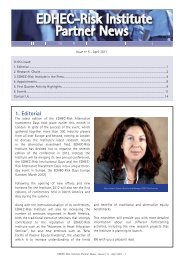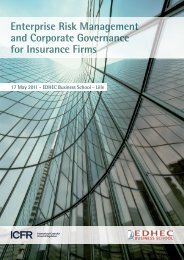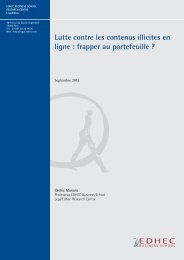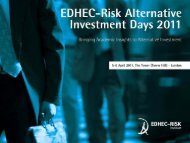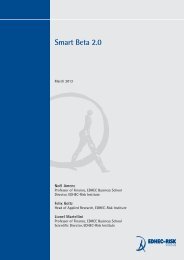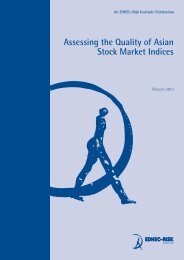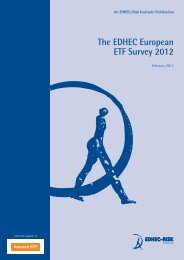The Smart Beta 2.0 Approach - EDHEC-Risk
The Smart Beta 2.0 Approach - EDHEC-Risk
The Smart Beta 2.0 Approach - EDHEC-Risk
Create successful ePaper yourself
Turn your PDF publications into a flip-book with our unique Google optimized e-Paper software.
An ERI Scientific <strong>Beta</strong> Publication — <strong>Smart</strong> <strong>Beta</strong> <strong>2.0</strong> — April 2013<br />
Copyright © 2013 ERI Scientific <strong>Beta</strong>. All rights reserved. Please refer to the disclaimer at the end of this document.<br />
13<br />
1. <strong>The</strong> <strong>Risk</strong>s of <strong>Smart</strong> <strong>Beta</strong> Strategies<br />
Exhibit 4: Concentration of Minimum Volatility portfolios in low volatility stocks – <strong>The</strong> universe contains 100 stocks, the volatilities of which are<br />
equally spaced in the corresponding intervals. Correlations between stock returns are assumed constant. <strong>The</strong> Global Minimum Variance (GMV)<br />
portfolios are long-only. For additional details, see Amenc, Goltz and Stoyanov (2011). <strong>The</strong>se results are based on equally spaced volatilities between<br />
16% and 18%.<br />
Ultimately, it is often only by imposing specific sector constraints associated with minimal and<br />
maximal weights per stock that indices based on minimum volatility approaches avoid the<br />
problems posed by their natural over-concentration. <strong>The</strong> question then arises of the influence of<br />
these constraints, which are necessarily defined ex-post on the historically simulated performance<br />
of these indices that were created very recently.<br />
1.2 Identifying Specific <strong>Risk</strong>s of <strong>Smart</strong> <strong>Beta</strong> Investing<br />
<strong>The</strong> second type of risk to which investors are exposed when they use a benchmark is the risk that<br />
is specific to the construction of that benchmark. Whatever the weighting scheme envisaged, it<br />
relies on modelling assumptions and on parameter estimation, which obviously always leads to a<br />
risk of a lack of out-of-sample robustness. Any investor who strays from a weighting scheme such<br />
as capitalisation weighting, for which the assumptions that determine the construction are largely<br />
open to criticism and not proven, and whose outputs are hardly compatible with the definition of a<br />
well-diversified portfolio, will probably take a well-rewarded risk, in the sense that there is a strong<br />
probability of doing better in the long term. 9 However, by moving away from the consensus, from<br />
the default option constituted by the cap-weighted indices, this investor will be questioned on<br />
the relevance of the new model chosen and on the robustness of the past performance that will<br />
probably underpin their choice to a large degree. In this sense, like in the area of systematic risk,<br />
every informed <strong>Smart</strong> <strong>Beta</strong> investor will have to be clear-sighted and carry out sound due diligence<br />
to evaluate the specific risks rather than rely only on an assessment of the past performance of the<br />
index.<br />
We believe that the specific risk dimension should be better taken into account in the choices<br />
that investors make in the area of <strong>Smart</strong> <strong>Beta</strong>. Too often investors stop at performances that are<br />
9 - It is often argued that cap-weighting can be justified by Sharpe's (1964) Capital Asset Pricing Model (CAPM). It should be recognised that not only the<br />
many assumptions underlying the CAPM are highly unrealistic (e.g., the presence of homogenous expectations and the absence on non tradable assets<br />
to name just a few), but also that the CAPM predicts that the true market portfolio, as opposed to any given cap-weighted equity index, is an efficient<br />
portfolio. In fact, it is internally inconsistent for the unobservable (Roll's, 1977, critique) cap-weighted true market portfolio to be efficient and for a capweighted<br />
equity portfolio extracted from the whole investment universe to be also efficient. This is because the design of an efficient equity portfolio<br />
taken in isolation from the rest of the investment universe ignores the correlation of selected stocks with the rest of the investment universe, while these<br />
correlations are taken into account in the design of an efficient portfolio for the whole investment universe. In other words, if it was the true asset pricing<br />
model the CAPM would predict that a cap-weighted equity portfolio cannot be an efficient portfolio since it instead predicts that the true market portfolio<br />
is an efficient portfolio. See also "Cap-Weigted Portfolios" section in the Appendix.




